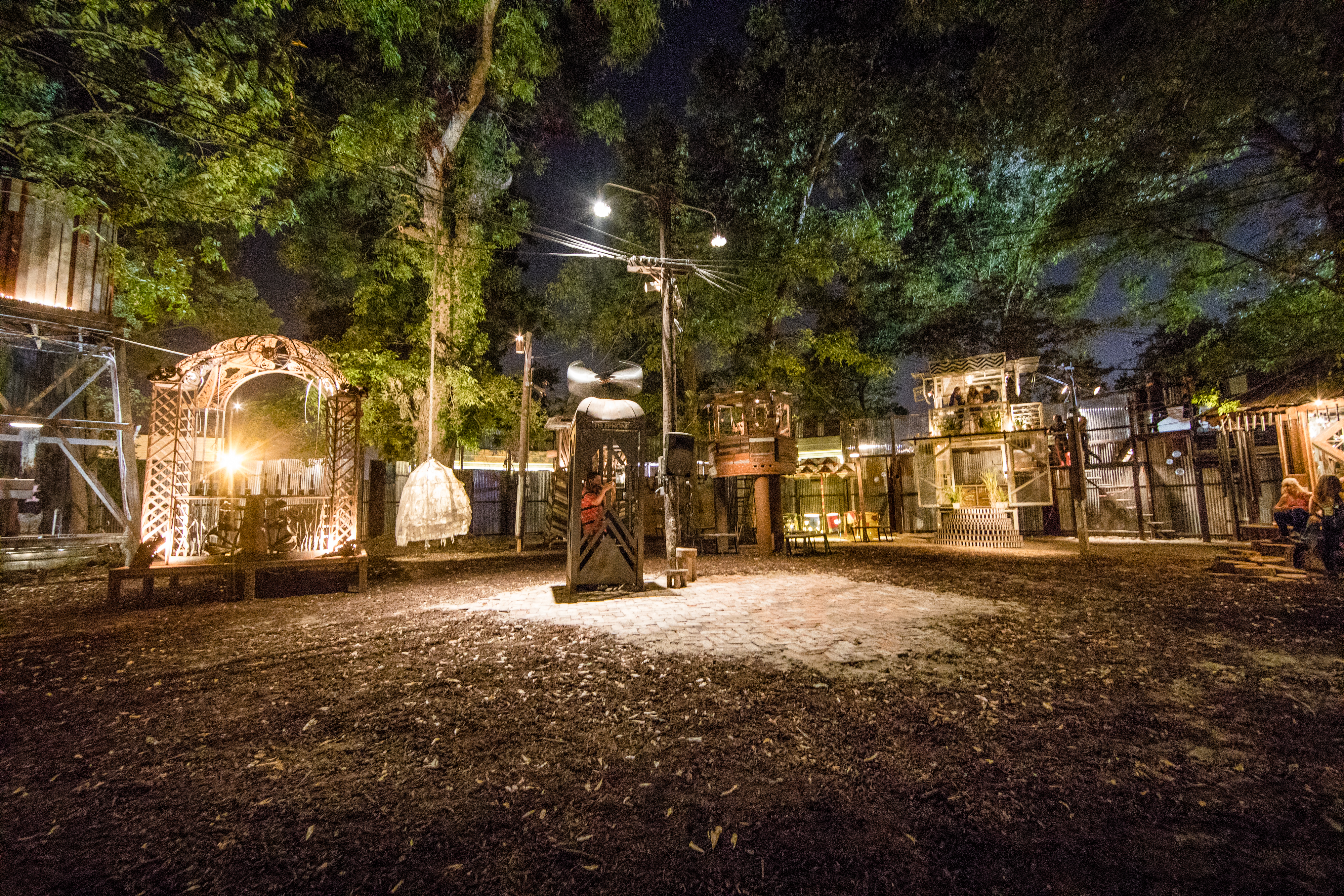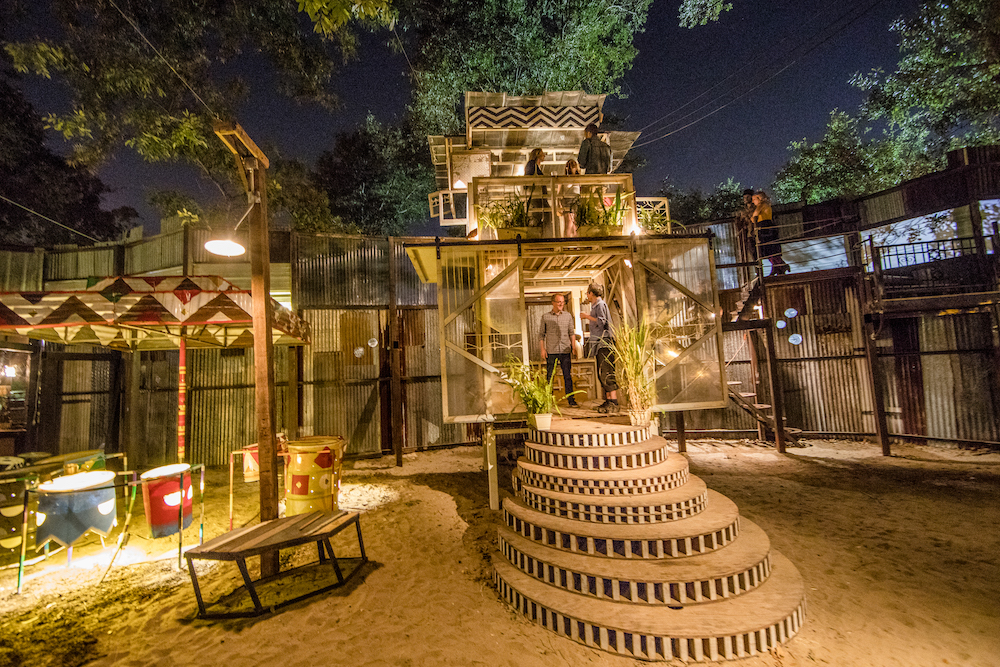About an hour before the start of performances at the grand opening night of Music Box Village last month, Jay Pennington and Delaney Martin were standing on the staircase of a structure resembling a miniature Japanese pagoda, making final preparations for the evening’s concert. As they spoke, a curious patron tried to enter the tiny building, and was surely surprised when it emitted an unearthly moan.
Located in the former yard of a large-scale steel fabricator in the Bywater neighborhood of New Orleans, Music Box Village is an art-installation-slash-music-venue featuring a collection of shanties and ramshackle treehouses that explode with music when they are opened, or tugged on, or smacked with a stick. There’s a collection of painted buckets and oil drums under a canopy, like a psychedelic version of a Trinidadian steel pan set. There’s a shed with enormous wind chimes, each tuned and labeled with the name of a musical note that plays when the wind or an enthusiastic attendee with a mallet comes by. There’s a telephone booth, whose microphone and rotating speakers throw a performer’s voice across the venue. There’s a stilted structure that looks like it might begin hovering at any moment, with fans that evoke helicopter rotors. When you pull on the ropes that dangle beneath the fans, they begin spinning quickly enough to emit celestial whistles and hums, as the plastic piping that entangles their blades catches the air like a whirly tube.
Pennington nodded at the pagoda’s sliding doors, whose tracks had been ingeniously rigged with a steel string and guitar slide, then connected to a hidden amplifier. Any time an attendee used the doors, they produced a hollow, mournful sound like what you might imagine coming from an undead blues musician. The effect was startling and lovely, but on that Friday evening, it was getting in the way of the sound check. “They’re running right for for it!” Pennington said to Martin. “Maybe if we close these, they won’t even realize they can go in.”
The current incarnation of Music Box Village opened its doors this year, but the project has existed in some form or another since 2011. Martin and Pennington are the cofounders of Airlift New Orleans, an organization that sprung up in the wake of Hurricane Katrina with hopes of helping artists and musicians who’d been devastated by the storm to find audiences inside and outside the city. One of their earliest projects was an itinerant musical village, conceived by Martin with help from the street artist Swoon and Airlift technical director Taylor Shepherd, built in part with materials from a collapsing 18th-Century house next to Pennington’s. Initially, the village was only intended as a venue to experiment with techniques that would later be implemented on a single large musical structure. “But once we did the smaller houses, we realized that it was so fun and spatially sonic,” Martin said. “It was also this collaborative juggernaut. We could make these musical houses and work with different people and grow this whole village.”
The team built the first Music Box near Pennington’s house, then set up shop around New Orleans, and in cities like Tampa Bay and Shreveport. As they traveled, they asked fellow artists and musicians to create their own musical houses to add to the collection. The Bywater location, which was purchased in April and features the work of over 80 collaborating artists, represents Music Box Village’s first permanent home. The aesthetic of the place, all corrugated metal and weathered wood, is apocalyptic DIY: Music Box Village is what a city might look like after a disaster that wiped out every living being save for a vanguard of interactive sculptors and noise musicians. Each member of the team has their own artistic practice. Swoon has exhibited her wheatpaste portraits at the Brooklyn Museum and the New Orleans Museum of Art; Pennington, better known by the moniker Rusty Lazer, is the former DJ and manager of New Orleans bounce rappers Big Freedia and the late Nicky da B.

Following a soft opening in early October, the Airlift team and their motley crew of staffers and volunteers were preparing for the venue’s first formal concert a few days before Halloween. TV on the Radio guitarist Kyp Malone was headlining, performing a skeletal and wrenching set of solo songs. The singer-songwriter Erin Durant, one of Malone’s tourmates, had toyed with the idea of using the telephone booth for a spatial vocal effect in one of her songs, but a malfunctioning speaker sidelined that plan. The performers would be giving a concert using only their traditional instruments.
At the soft opening, Music Box Village hosted an ensemble of local musicians, led by the one-man-band Quintron, who actually played the houses. The Times-Picayune raved about their “abstract music that wound its way stylistically from Stravinsky to Tom Waits to New Orleans bounce.” In the coming weeks, the venue will host shows from a slate of acts notable for their willingness to toy with and update traditional sounds, many of whom have deep roots in the city: upcoming local soul band Tank and the Bangas with Big Freedia, the cajun music modernists Lost Bayou Ramblers, and beloved Gypsy punks Gogol Bordello.
I talked to the artist Adriana Atema, who performs meditative songs for piano and guitar under the name Okolona Is Adriana. Atema once recorded an entire improvisatory album on the houses at the original Music Box location, and she was performing alongside Malone and Durant on the opening evening of the new one. “As a kid, I used to wait for the car to go out of the gravel driveway, so I could bang the pots and pans and make as much noise as I could,” she said, wearing a pink cowboy hat. She was standing under a small room on stilts, filled with pots and pans intended for just that purpose. Ian Vanek of Japanther, who designed the musical kitchen, had wanted to include a whistling tea pot filled with boiling water. (“We were like, ‘There are children!’’ Pennington said. “Thank you, but no thank you.”)
An hour or two later, the sun was down, the village was filled with spectators, and Atema was performing a whispering folk song at a three-quarters sized piano. “I know our friendship is golden, and I’m going to throw it into the fire,” she sang. Just then, a wayward patron stepped under a miniature water tower behind her, triggering an impossibly loud blast of foghorn. For a hushed moment, it was impossible to tell whether the absurd intrusion was going to enhance her performance or derail it. “That’s pretty cool,” she said into the mic, halting her song and breaking into laughter. “It’s the fire.” She kept playing.
Later, Malone addressed the audience between songs in his headlining set. “What if we all just stayed here and collectively wrote a musical, using all the different installations?” As he was nearing the end of his performance, a high metallic whine met his falsetto in twisted harmony, and a handful of patrons looked around for the source of this latest interruption, wondering whether someone had taken his remark literally. But it was just the train going by, one of the Music Box Village’s many invisible accompanists at work.





